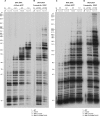Analysis of the Zidovudine Resistance Mutations T215Y, M41L, and L210W in HIV-1 Reverse Transcriptase
- PMID: 26324274
- PMCID: PMC4649230
- DOI: 10.1128/AAC.05069-14
Analysis of the Zidovudine Resistance Mutations T215Y, M41L, and L210W in HIV-1 Reverse Transcriptase
Abstract
Although anti-human immunodeficiency virus type 1 (HIV-1) therapies have become more sophisticated and more effective, drug resistance continues to be a major problem. Zidovudine (azidothymidine; AZT) was the first nucleoside reverse transcriptase (RT) inhibitor (NRTI) approved for the treatment of HIV-1 infections and is still being used, particularly in the developing world. This drug targets the conversion of single-stranded RNA to double-stranded DNA by HIV-1 RT. However, resistance to the drug quickly appeared both in viruses replicating in cells in culture and in patients undergoing AZT monotherapy. The primary resistance pathway selects for mutations of T215 that change the threonine to either a tyrosine or a phenylalanine (T215Y/F); this resistance pathway involves an ATP-dependent excision mechanism. The pseudo-sugar ring of AZT lacks a 3' OH; RT incorporates AZT monophosphate (AZTMP), which blocks the end of the viral DNA primer. AZT-resistant forms of HIV-1 RT use ATP in an excision reaction to unblock the 3' end of the primer strand, allowing its extension by RT. The T215Y AZT resistance mutation is often accompanied by two other mutations, M41L and L210W. In this study, the roles of these mutations, in combination with T215Y, were examined to determine whether they affect polymerization and excision by HIV-1 RT. The M41L mutation appears to help restore the DNA polymerization activity of RT containing the T215Y mutation and also enhances AZTMP excision. The L210W mutation plays a similar role, but it enhances excision by RTs that carry the T215Y mutation when ATP is present at a low concentration.
Copyright © 2015, American Society for Microbiology. All Rights Reserved.
Figures







Similar articles
-
Effects of the Delta67 complex of mutations in human immunodeficiency virus type 1 reverse transcriptase on nucleoside analog excision.J Virol. 2004 Sep;78(18):9987-97. doi: 10.1128/JVI.78.18.9987-9997.2004. J Virol. 2004. PMID: 15331732 Free PMC article.
-
Nucleoside analog resistance caused by insertions in the fingers of human immunodeficiency virus type 1 reverse transcriptase involves ATP-mediated excision.J Virol. 2002 Sep;76(18):9143-51. doi: 10.1128/jvi.76.18.9143-9151.2002. J Virol. 2002. PMID: 12186898 Free PMC article.
-
Molecular basis of the association of H208Y and thymidine analogue resistance mutations M41L, L210W and T215Y in the HIV-1 reverse transcriptase of treated patients.Antiviral Res. 2014 Jun;106:42-52. doi: 10.1016/j.antiviral.2014.03.004. Epub 2014 Mar 22. Antiviral Res. 2014. PMID: 24667336
-
Mutational patterns in the HIV genome and cross-resistance following nucleoside and nucleotide analogue drug exposure.Antivir Ther. 2001;6 Suppl 3:25-44. Antivir Ther. 2001. PMID: 11678471 Review.
-
Mechanisms of resistance to nucleoside analogue inhibitors of HIV-1 reverse transcriptase.Virus Res. 2008 Jun;134(1-2):124-46. doi: 10.1016/j.virusres.2007.12.015. Epub 2008 Feb 12. Virus Res. 2008. PMID: 18272247 Review.
Cited by
-
Affordable drug resistance genotyping of HIV-1 reverse transcriptase, protease and integrase genes, for resource limited settings.AIDS Res Ther. 2023 Feb 9;20(1):9. doi: 10.1186/s12981-023-00505-3. AIDS Res Ther. 2023. PMID: 36759801 Free PMC article.
-
Cuban history of CRF19 recombinant subtype of HIV-1.PLoS Pathog. 2021 Aug 9;17(8):e1009786. doi: 10.1371/journal.ppat.1009786. eCollection 2021 Aug. PLoS Pathog. 2021. PMID: 34370795 Free PMC article.
-
An analysis of drug resistance among people living with HIV/AIDS in Shanghai, China.PLoS One. 2017 Feb 10;12(2):e0165110. doi: 10.1371/journal.pone.0165110. eCollection 2017. PLoS One. 2017. PMID: 28187212 Free PMC article.
-
A Combination of Amino Acid Mutations Leads to Resistance to Multiple Nucleoside Analogs in Reverse Transcriptases from HIV-1 Subtypes B and C.Antimicrob Agents Chemother. 2022 Jan 18;66(1):e0150021. doi: 10.1128/AAC.01500-21. Epub 2021 Nov 1. Antimicrob Agents Chemother. 2022. PMID: 34723625 Free PMC article.
-
Two Coselected Distal Mutations in HIV-1 Reverse Transcriptase (RT) Alter Susceptibility to Nonnucleoside RT Inhibitors and Nucleoside Analogs.J Virol. 2019 May 15;93(11):e00224-19. doi: 10.1128/JVI.00224-19. Print 2019 Jun 1. J Virol. 2019. PMID: 30894467 Free PMC article.
References
-
- Hughes SH. 2015. Reverse transcription of retroviruses and LTR retrotransposons, p 1051–1070. In Craig NL, Chandler M, Gellert M, Lambowitz AM, Rice PA, Sandmeyer S (ed), Mobile DNA III. ASM Press, Washington, DC.
Publication types
MeSH terms
Substances
Grants and funding
LinkOut - more resources
Full Text Sources

